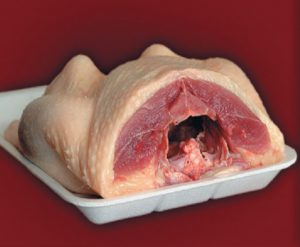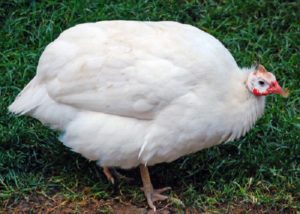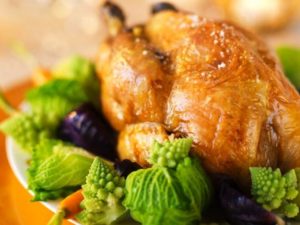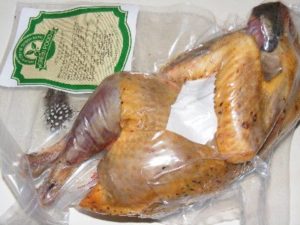Content
- 1 The chemical composition of guinea fowl meat
- 2 Nutritional value and calorie content of guinea fowl meat
- 3 Why is guinea fowl meat useful?
- 4 What is the difference between guinea fowl meat and chicken
- 5 Is guinea fowl meat possible for pregnant and lactating women
- 6 Is guinea fowl meat good for children?
- 7 How to properly cook guinea fowl meat
- 8 What is the combination of guinea fowl meat
- 9 Harm of guinea fowl meat and contraindications to use
- 10 How to choose and store guinea fowl meat
- 11 Conclusion
- 12 Reviews
The benefits and harms of guinea fowl meat, properties and composition - the necessary information to include it in the diet. Guinea fowl is an unusual product for the post-Soviet space. It looks like a chicken, but there are some differences.

The chemical composition of guinea fowl meat
Poultry meat contains all the nutrients and vitamins necessary for the human body and has many useful properties. It includes:
- B vitamins;
- choline;
- vitamin C;
- vitamin PP;
- magnesium;
- zinc;
- threonine;
- valine;
- histidine;
- tin;
- cobalt;
- copper;
- chlorine;
- iron;
- sodium and others.
Nutritional value and calorie content of guinea fowl meat
Guinea fowl is a dietary meat recommended by doctors for losing weight and keeping fit. Its benefits and calorie content depend on the method of preparation and additional ingredients. 100 g contains 110 kcal, 20.6 g of proteins, 2.5 g of fat. The benefit is also the absence of carbohydrates.
Why is guinea fowl meat useful?
Contains more protein than other birds. It also contains a significant number of micro- and macroelements, minerals, amino acids. The benefits are manifested in recovery after surgery and long-term illnesses, diets. The properties of the product help to strengthen the immune system, prevent heart and vascular diseases.
The benefits are manifested when:
- anemia;
- diseases of the central nervous system;
- metabolic disorders;
- strong nervous tension and stress;
- colds;
- viruses and infections.
Contains healthy cholesterol. The benefits of the constituent elements have a complex effect on the body, helping to fight ailments. It also helps to normalize digestion, serves as a prophylactic agent in the fight against diseases of the eyes and skin.
What is the difference between guinea fowl meat and chicken

It looks like chicken, but raw meat is darker in color. The percentage of muscle mass is greater than that of others. When heat treated, the color becomes close to chicken. Guinea fowl tastes like pheasant or partridge. Poultry is more dietary than chicken, the content of amino acids and vitamins is higher. The bones are thinner, the breasts are denser and larger. The beneficial properties, due to the chemical composition, are more significant than in chicken.
Is guinea fowl meat possible for pregnant and lactating women
Guinea fowl is recommended during pregnancy due to its beneficial properties: vitamins and nutrients. Helps relieve nervous tension, fatigue during gestation. Breastfeeding is not a contraindication to use. Since it is a hypoallergenic product, doctors recommend including dietary meat in the diet during pregnancy and lactation.
Is guinea fowl meat good for children?
The benefits for children are also determined by the chemical composition and properties.The absence of allergies and low risks of harm, the ability to restore strength, eliminate nervous tension - these characteristics serve as recommendations for use. Used as complementary food for newborns. Before use, it is imperative to consult a pediatrician.
How to properly cook guinea fowl meat

The taste of guinea fowl meat is revealed with the right preparation and selection of ingredients. There are several tips for preparing a healthy and tasty dish:
- To make the carcass more tender, it is recommended to bake it with bacon or other fatty foods.
- To soften, marinate the bird. This process will not reduce the amount of nutrients in the meat. If you plan to cook a fried dish, then you do not need to marinate for a long time, otherwise you will get a dry product.
- It is recommended to cook longer than chicken.
- Chefs prefer fried foods. But you can also bake, stew and cook.
What is the combination of guinea fowl meat
The poultry goes well with vegetables prepared in a variety of ways. With this option, the beneficial properties and juiciness of the products are preserved. In Greek cuisine, the recipe for fried guinea fowl with tomatoes and olives is common.
Classic cooking methods and combinations are:
- stewed in red wine;
- carcass stuffed with cottage cheese and herbs;
- stewed poultry with vegetables;
- carcass with rosemary and lemon.
Also cinnamon, curry and other common spices are added as seasonings.
It should be remembered that a dish fried in an excessive amount of oil is harmful to the digestive tract. In this case, the food becomes too greasy.

Harm of guinea fowl meat and contraindications to use
Excessive consumption leads to congestion of the gastrointestinal tract, a feeling of heaviness and pain. Cases of individual intolerance and rare diseases are possible. There are no other contraindications and harm from use. With cardiovascular diseases and diabetes, guinea fowl meat and eggs are allowed due to their low calorie content and fat content.
How to choose and store guinea fowl meat
The benefits of the finished dish directly depend on the choice of a quality carcass:
- It is recommended to pay attention to the age of the guinea fowl. The most dietary and healthy are the carcasses of 3-month-old birds.
- There should be no bruises or spots on the meat.
- A quality product has no foreign or unpleasant odors.
- The color of the carcass is bluish, darker than that of a chicken.
- It is recommended to buy in special packaging in the store.
It is stored refrigerated for no more than two days. Frozen retains useful properties and freshness for 3-4 months.

Conclusion
The benefits and harms of guinea fowl meat are due to its properties and its constituent vitamins. There are practically no contraindications to use, therefore the product is recommended for pregnant and lactating women, newborns and the elderly and does not harm the body.

